Polar Bear (<i>Ursus maritimus</i>) Behavior near Icebreaker Operations in the Chukchi Sea, 1991
DOI:
https://doi.org/10.14430/arctic4566Keywords:
polar bear, Ursus maritimus, icebreaker, behavior, reaction, Arctic, human activity, icebreaking, Chukchi Sea, drillingAbstract
Increasing interactions of polar bears (Ursus maritimus) with human activity, combined with impacts of climate change, are of critical concern for the conservation of the species. Our study quantifies and describes initial reactions and behaviors of polar bears observed from an icebreaker during summer 1991 at two exploratory drilling sites (near sites drilled in 2015) located in the Chukchi Sea 175 km and 312 km west of Barrow, Alaska. Polar bear behavior was described using continuous sampling of six predetermined focal group behavior states (walking, running, swimming, resting, feeding or foraging, unknown) and six behavioral reaction events (no reaction, walking away, running away, approaching, vigilance [i.e., watching], unknown). Forty-six bears in 34 groups were monitored from the Robert LeMeur (an Arctic Class 3 icebreaker) for periods of five minutes to 16.1 hours. Significantly more bear groups reacted to icebreaker presence (79%) than not (21%), but no relationship was found between their reactions and distance to or activity of the icebreaker. Reactions were generally brief; vigilance was the most commonly observed reaction, followed by walking or running away for short (< 5 minutes) periods and distances (< 500 m). Eleven percent of bear groups approached the vessel. No significant difference was found between reactions when cubs were present and those when cubs were absent. Despite the limited sample sizes, these findings are relevant to assessing potential impacts of resource development and shipping activities on polar bears, especially given the sparsity of such information in the face of growing human activity in the Arctic offshore areas. Overall, climate change is leading to longer and more extensive open-water seasons in the Arctic and therefore to increasing marine traffic—more vessels (including icebreakers) for a longer time each year over a wider area.


